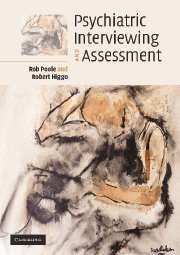Book contents
- Frontmatter
- Contents
- Acknowledgements
- Introduction
- Part I What am I trying to find out here?
- Part II The main principles of one-to-one interviewing
- 5 Office-based psychiatric assessment
- 6 Understanding and managing relationships with patients
- Part III The difficult interview
- Part IV Self-awareness
- Part V Out of the clinic
- Part VI Drawing it all together
- Afterword: getting alongside patients
- References
- Index
5 - Office-based psychiatric assessment
from Part II - The main principles of one-to-one interviewing
Published online by Cambridge University Press: 06 September 2009
- Frontmatter
- Contents
- Acknowledgements
- Introduction
- Part I What am I trying to find out here?
- Part II The main principles of one-to-one interviewing
- 5 Office-based psychiatric assessment
- 6 Understanding and managing relationships with patients
- Part III The difficult interview
- Part IV Self-awareness
- Part V Out of the clinic
- Part VI Drawing it all together
- Afterword: getting alongside patients
- References
- Index
Summary
It is said that in football, everything is complicated by the presence of the opposing team. A very similar principle applies in clinical interviews. The technical tasks outlined in Part I are quite complicated in themselves, but what really makes the situation demanding is the presence of the patient, who is likely to have unpredictable expectations and needs.
There are some key tasks that have to be carried out in any successful assessment interview. Firstly, and perhaps most importantly, the psychiatrist has to establish the foundations of a relationship with the patient. It is self-evident that a good relationship with the patient is desirable, and that symptom relief (let alone recovery) is unlikely against the backdrop of a poor relationship. What is less obvious is the exact nature of a good relationship, as it does not necessarily involve doing everything the patient wants.
Secondly, a large amount of historical information has to be collected and organised, whilst carefully observing the patient and carrying out a mental state examination.
Thirdly, the psychiatrist must arrive at both a diagnosis and a thorough understanding of the patient's problems and the context within which they have arisen. This includes an assessment of risk.
Fourthly, all of this has to be explained to the patient in a form that they can understand.
Finally, the psychiatrist has to decide what interventions are likely to be helpful, negotiate a treatment plan with the patient, and persuade them to follow it.
Fortunately, these tasks overlap with each other.
- Type
- Chapter
- Information
- Psychiatric Interviewing and Assessment , pp. 65 - 79Publisher: Cambridge University PressPrint publication year: 2006



